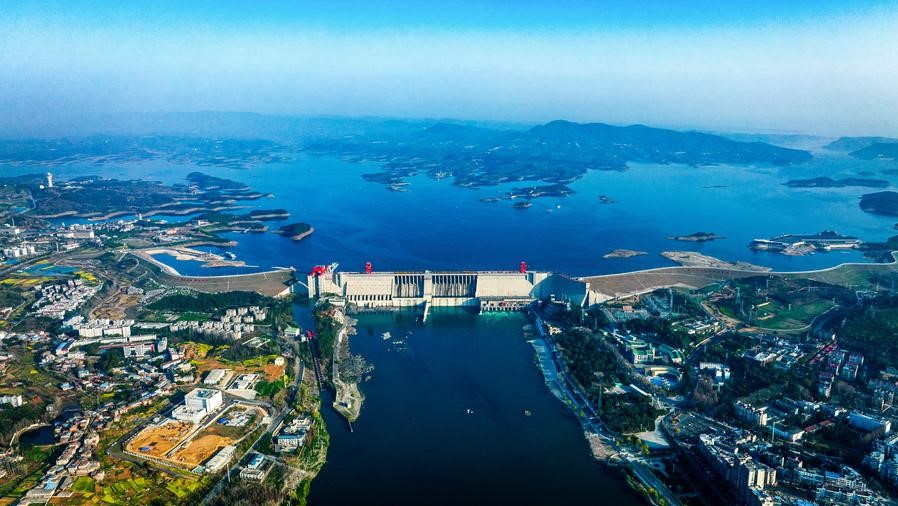
 0 Comment(s)
0 Comment(s) Print
Print E-mail Xinhua, December 26, 2024
E-mail Xinhua, December 26, 2024
An aerial drone photo taken on March 22, 2024 shows a view of the Danjiangkou Reservoir in central China's Hubei Province. [Photo/Xinhua]
China's South-to-North Water Diversion Project, the largest of its kind globally, has dramatically transformed northern and southern China over the past decade.
The mega water diversion project channels water over long distances from the country's water-rich south to its northern regions, where hundreds of millions once endured "absolute water scarcity" as defined by United Nations standards.
By alleviating chronic water shortages, revitalizing industries, and redefining the relationship between people and nature, this engineering masterpiece transcends its role as a water transfer system. It stands as a catalyst for progress and sustainability.
From vision to reality
China's per capita water resources are significantly below the global average and are unevenly distributed across the country. The Yangtze River Basin frequently experiences flooding, while northern regions face severe water shortages, hindering economic development.
Recognizing the critical importance of water resource management for national prosperity, the Chinese government launched extensive water conservancy projects nationwide after 1949.
The South-to-North Water Diversion Project, a prime example of these efforts, was conceived in the 1950s and saw the first phases of its middle and eastern routes become operational in late 2014.
Designed with three routes, the project stretches across four of China's major river basins: the Yangtze, Huaihe, Yellow and Haihe.
The eastern route leverages ancient canals, starting from the city of Yangzhou in east China's Jiangsu Province, and uses 13 pumping stations to lift water.
On the other hand, the middle route relies on gravity to transport water from the Danjiangkou Reservoir, primarily located in central China's Hubei Province, to regions such as Henan, Hebei, Beijing and Tianjin. The reservoir is situated on the Hanjiang River, a tributary of the Yangtze River.
During the past decade, the project has diverted more than 76.7 billion cubic meters of water to the country's northern regions, benefitting 185 million people in 45 cities, according to data from the Ministry of Water Resources.
Moreover, in western Hubei, a newly launched project, with an investment of 55.16 billion yuan (about 7.67 billion U.S. dollars), aims to connect the Three Gorges Reservoir with the Hanjiang River. By 2031, this project is expected to increase the middle route's annual water transfer capacity to 11.5 billion cubic meters, from the current 9.5 billion cubic meters.
According to the China South-to-North Water Diversion Corporation, future plans also include extending the eastern route and developing the western route to deliver water to the northwest regions along the Yellow River.
Concerted efforts
"The most noticeable change (brought about by the mega water project) is the reduction of limescale in kettles," said Wang Daoxi, Vice Minister of Water Resources, earlier this month at a press conference.
Thanks to the transfer of water from the south, Beijing's tap water hardness has decreased, and over five million people in neighboring Hebei Province no longer have to drink high-fluoride or saline water, Wang noted.
Dai Yinyu, a 73-year-old villager from Cangxian County in Hebei, hailed the transformation, calling the Yangtze River water a "blessing." "Now, the children here drink clean water, have healthier teeth, and eat with ease."
In addition to providing drinking water, the project has replenished more than 50 rivers and helped revitalize the Baiyangdian Lake -- often called the "Pearl of North China."
Meanwhile, the Chinese government has emphasized water-saving measures, prompting regions along the routes to adopt ecological and sustainable development policies.
Responding to the call for water conservation, citizens, businesses and institutions in water-receiving regions are actively contributing to saving water in various ways.
Water recycling technology adopted by a base of Nine Dragons Paper (Holdings) Limited in Tianjin saves 32 million cubic meters of water annually.
By 2025, water consumption per 10,000 yuan of GDP in the water-receiving regions must be capped at 33 cubic meters or less, according to an official guideline issued in 2023.
Beijing has also implemented stricter legal measures. Violations such as illegal water usage in public facilities will incur fines ranging from 10,000 to 100,000 yuan for organizations and 1,000 to 10,000 yuan for individuals.
"Protecting and conserving every drop of water is our responsibility," said 66-year-old Beijing resident He Yufeng, who has actively participated in water source protection activities at the Danjiangkou Reservoir.
Development through protection
In recent years, the water quality of the Danjiangkou Reservoir has remained excellent. In 2023, the reservoir recorded 335 days of Class I water quality, up from 252 days in 2021 and 206 days in 2022.
As an innovative approach to water source protection, the city of Shiyan in Hubei, which is in the reservoir area, has developed a digital platform to monitor and ensure the reservoir's water quality.
The platform leverages satellites, drones and advanced detection instruments to monitor the water quality of the reservoir and its inflowing rivers in real time.
It also tracks discharges from key enterprises and underground drainage networks, issuing immediate alerts when problems are detected.
In Shiyan, stricter protection measures have driven the city's economic transformation and created new growth opportunities. Wang Yonghui, the mayor of Shiyan, highlighted the city's commitment to environmental protection by rejecting over 100 high-pollution projects and phasing out outdated capacities in industries like cement, steel and paper.
At the same time, Shiyan has promoted the transformation of its automotive sector toward new energy and smart technologies while fostering the growth of ecological agriculture. Last year, the city's GDP grew by 6.1 percent and reached 235.9 billion yuan, according to Wang.
Meanwhile, greater involvement from grassroots organizations has fostered wider participation in water source protection.
In the city of Danjiangkou, administered by Shiyan and home to the Danjiangkou Dam, 90,000 people have joined a local water protection volunteer group called "Xiaoshuidi" or "Droplets."
Points earned through participation in volunteer work can be used for discounts on public transportation, tourism, and even housing, according to local authorities.
Jiang Dexin, 63, a former fisherman and one of the volunteers, gave up fishing to help protect the reservoir's water. He now dedicates his efforts to clearing floating debris on the Hanjiang River.
"The water of the Hanjiang River, wherever it flows, should remain clean," said Jiang. "Now, with growing environmental awareness, an increasing number of volunteers are getting involved."